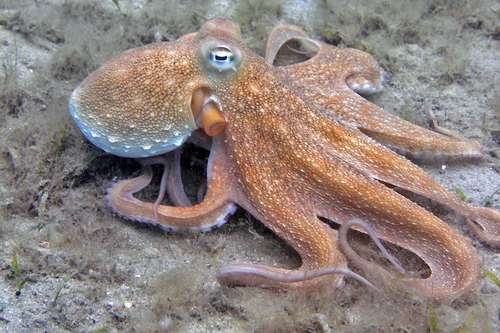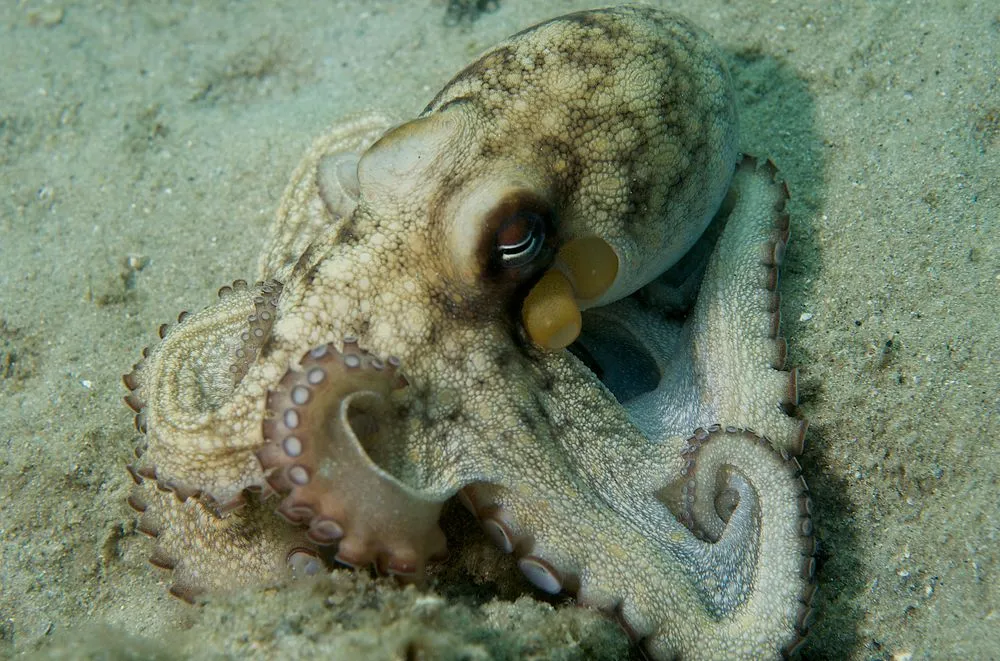
Description:
Scientific Name: Octopus bimaculoides
Lifespan: 1-1.5 years in the wild, up to 2 years in captivity
The California two-spot octopus gets its name from the two distinguishing spots under each eye, which are often pale brown or mottled in colour. Eight tentacles surround its mantle, which is shaped like a pear and has a beak and mouth in the center. Each of its tentacles expands to a length of a few feet, which is slightly larger than its body size. Each of its tentacles is equipped with a suction cup that can be utilized to taste as well as grasp and retain prey. When fully grown, the octopus can reach a length of about 18 inches. When seeking for prey or hiding from predators, Octopus bimaculatus can alter its colour and texture using the chromatophores in its skin, just like its relatives. Due to their similar appearances, Octopus bimaculoides and Octopus bimaculatus share the same common name; however, it is crucial to understand that these two octopus species are distinct from one another.
Habitat:
Off the coast of Northern California and south to Baja California, Mexico, you can find the octopus bimaculatus. The Channel Islands have also contributed many observations. To a depth of 15 metres, Octopus bimaculatus lives on stony reefs in subtidal and intertidal settings. It loves to make its burrow in narrow crevices in canyon cliffs or disused man-made pipework.
Behavior:
The California two-spotted octopus is one of many octopus species that are mostly active at night. At night, Octopus bimaculatus departs from its den to go hunting and mate. It is capable of nocturnal behaviour thanks to its highly developed eyes. When not hunting, individuals travel far in search of food and find temporary shelter in burrows. They never build their own dens and don’t frequently go back to their old ones. Octopuses will fight each other for dens, ejecting conspecifics from a den they want. In order to digest their meal, they will bring it to their dens, leaving behind “middens” of varied bivalve shells, crab claws, and other tough portions of their invertebrate diet.

Keeping as a Pet/ In Captivity
In a species tank, that is 50 gallons or bigger, a bimac should be maintained alone. Up to three months may be required to properly cycle and develop the tank. To prevent escape, the tank needs to be covered and well sealed. Bimacs prefer hiding places made of sand, rock, or numerous lengths of PVC pipe. The recommended temperature for a home aquarium for bimacs is between 65 and 72 degrees F (18 and 22 degrees C). A 30-watt daylight spectrum lamp running for 8–10 hours per day should be sufficient for their lighting needs. Covering every powerhead intake and overflow opening with mesh or netting is a good idea. To protect the filters and other equipment from the octopus, which can obstruct fittings, a sump might be built to hold them all.
Water parameters
Salinity – 1.026, pH- 8 – 8.4, NO3 – 0, NO2- 0, NH3 – <30 ppm, Copper – 0
Copper (Cu), ammonia (NH3), and nitrite (N02) are all toxic to octopuses, but they can tolerate modest levels of nitrates. 10% to 20% partial water changes per week or every two weeks are advised.
The Two-Spot Octopus thrives in oceans with temperatures between 65 and 72 degrees Fahrenheit because it prefers the warmer water. They are one of the species that humans are more likely to witness because they typically operate and reside 65 feet below the surface.
Feeding
Hatchlings are fed either mysid prawns or amphipods. Then some are given baby clams and baby crabs to eat. You can put the clams in a tiny shell or a shallow basin. While simpler to capture than shore shrimp for young octopus, ghost shrimp are not recommended for long-term use. They can also consume hermit crabs when they are young. Most won’t eat anything but live food until they’re a few months old. Then, fresh scallops live fiddler crabs, live beach prawns and finally larger crabs (crabs should be smaller than the octopus’s mantle) can be offered. Some may accept fresh fish pieces (never use goldfish), and everyone seems to enjoy crayfish. Never offer more food than the octopus can consume in a single sitting since any food left behind could rot or go bad, polluting the tank. Bimacs who are three months old or younger should be fed multiple times per day.
Table





